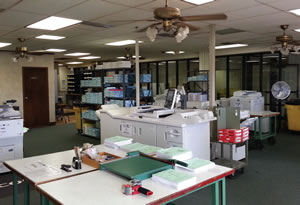Outsourcing Is In
- By Michael Fickes
- 06/01/14

PHOTOS COURTESY OF RICOH AND ST. LOUIS PUBLIC SCHOOLS
Since the recession, outsourcing non-instructional services by K-12 school districts has become more respectable, and more and more districts are taking up the practice.
To be sure, outsourcing has always been around, but it has lacked respectability. Critics charge that outsource providers replace existing employees, cut wages to subsistence levels, wrest control of services from school districts, jack up prices upon acquiring a contract and don’t do as good a job as school employees that care about the school and its students.
The criticisms have suppressed the use of outsourcing. When the economy collapsed, however, states slashed budgets across the board. Caught short, districts across the country decided to test the claim that outsourcing saves money.
In fact, the tests seem to have produced positive results. Outsourcing is a growing trend. In a study of K-12 school district outsourcing in Michigan from 2001 through 2013, the Mackinac Center for Public Policy found that 31 percent of the state’s school districts outsourced one or more services in 2001.

Big Difference. In some instances, it the best way to solve a problem is to let someone else handle it. That was the case with the St. Louis Public School district’s printing and mailing Resource Center. The photo directly above shows the area before these services were outsourced. The other images accompanying the article are “after.”
By 2012, 60.7 percent of Michigan school districts were outsourcing one or more services.
The percentage rose substantially from 2012 to 2013 when 65.5 percent of districts reported outsourcing at least one service.
Clearly, attitudes toward outsourcing have changed. The trend toward outsourcing has in many cases disproved the criticisms leveled at outsourcing.
According to “Let Them Learn: Outsourcing To Fund America’s Classrooms,” a 2012 white paper issued by Smith Weaver Smith Inc., a consulting firm with an education specialty, outsourcing doesn’t cost jobs. “However, the research-based literature emphasizes that for the most part, current employees are retained by the contracting firm,” says the white paper. “What happens to current employees can also be included in the negotiated contract with the contractor.”
The white paper found little support for the other major criticisms — low wages, loss of control and lower quality work. Instead, employees found brighter prospects for promotion within the private company. Districts that negotiated responsible contracts maintained firm control over the services being outsourced.
Finally, given the high levels of competition in outsourcing, quality didn’t seem to suffer. In fact, the Mackinac study surveyed district satisfaction with 422 outsourced contracts and found that 93 percent of the districts were satisfied.
While the main categories of outsourcing remain custodial, food and transportation services, the continuing trend toward outsourcing has brought other services into the mix.
Print and mail services
Ricoh America Corp., for instance, provides document printing and mailroom services to St. Louis Public Schools and other school districts.
The largest K-12 school district in Missouri, St. Louis Public Schools comprises 27,000 students and 4,000 teachers at 75 locations plus three administrative offices.
All of the schools and administrative buildings rely on a centrally located printing and mail Resource Center. Over the years, the Resource Center had fallen into disarray. Hoping to remedy the problem with an outsource provider, the district issued a request for proposals last year. Ricoh won contracts to provide mail and printing services.
“A school district’s expertise is in education,” says Ryan O’Hearne, major account sales manager with Malvern, Pa.- based Ricoh America Corp. “Our expertise is in printing and moving documents.”
Reams of paper and litter lay on the floors and tables throughout printing area of the Resource Center. There was no dedicated area for paper stocks and other printing inventory needs. Surplus office furniture and broken equipment cluttered the space and even blocked the entrances.
The printing process had broken down too. The Resource Center lacked clear standards and procedures for submitting and accepting print jobs. As a result, misunderstandings and lost orders occurred frequently, and dissatisfied teachers and administrators often relied on expensive outside print vendors.
Under the contract, Ricoh deployed 240 new multi-function printers that can copy, print, scan, fax and email documents across the district. Ricoh also provided software that implemented enterprise-wide document management.
Next, Ricoh implemented software that enabled any location in the district to send documents electronically to the Resource Center for printing. The software also enabled card authentication at each multi-function printer and placed machine-readable stickers on the backs of all of the district ID badges. Users swipe the stickers to sign onto the network, which can then charge back accurately for printing services.
The new system enables faxing from all district schools and administrative buildings. The previous fax system only operated from one location.
 A “follow me” printing features now allows users in the administration building to send a job through the network and to retrieve documents at any district device simply by swiping their ID badges.
A “follow me” printing features now allows users in the administration building to send a job through the network and to retrieve documents at any district device simply by swiping their ID badges.
Another new machine automates the work of collating, stapling and binding brochures.
Finally, the district is currently testing a paperless homework process that will enable teachers to post homework assignments to a Microsoft SharePoint portal. It will enable students to download assignments and submit homework electronically.
Ricoh has also tuned up the district’s mail service, which had grown disorganized, slow and overly expensive. “Previously, for instance, the district was using an envelope stuffing machine located on the opposite side of the school from the print shop,” says Kirk Brawley, K-12 major account executive with Ricoh. “They printed mailings in the print shop, carried the letters to the envelope stuffing machine and then brought the stuffed envelopes back to the printing center to apply postage. After cleaning out the print shop, there was room for the stuffing machine. So that process has been consolidated. Now, a software application addresses envelopes and sends them through to postage, sorting the pieces into zip codes, which lowers postage costs.
The Ricoh team also investigated the district’s U.S. Postal Service account and discovered tens of thousands of dollars in an idle return mail account. Working with the Postal Service, Ricoh transferred the funds to the district’s non-profit account and incorporated a non-profit permit number on the districts indicia for future mailings.
The results are stunning: costs for printing and mailing have declined by 25 percent, while operating faster and more efficiently.
Outsourcing bids
School procurement officers don’t usually think of cooperative buying groups as an outsourcing alternative, but it is. Not only that, cooperatives will do the work you outsource to them free of charge.
What work is that? It is the complex work connected to developing requests for bid, evaluating the complicated responses and figuring out which one really is the best.
“I always tell staff to look for co-op contracts before we go through the effort and time to do a solicitation,” says Richard Gay, CPPO, RSBO, the purchasing manager for Baltimore County Public Schools. “It saves a lot of money. Industry estimates say that developing a bid solicitation costs between 3 percent and 6 percent of the contract.
“It also costs money to administer a program after the solicitation. You have to monitor what you receive and determine whether the conditions of the contract are being honored.
“All of these costs can be avoided by using a co-op contract.”
It takes time, too. Gay describes a recent Baltimore County Schools bid solicitation for 150,000 laptops that can be turned into tablets. “We spent four weeks field testing equipment in the classroom with teachers and students, observing how they used the devices,” he says. “Then we translated our observations into the specifications.
“Maryland law requires us to advertise for two weeks, but we left this solicitation out for six weeks to allow enough time for companies to drill down into the specs.
“It took another four weeks to evaluate the responses. If this were a request for proposal, you would have to add several more weeks for contract negotiations.”
The Baltimore County Schools solicitation also raises the question of expertise — in both bidding and in the products and services being solicited. If you don’t get the request for bid right, it probably won’t produce the results you want.
Co-op procurement groups employ experts in the field to issue and evaluate requests for bids and proposals. Office supply experts bid out and manage contracts for office supplies; mechanical experts bid out and manage contracts for HVAC equipment; and so on.
“Co-op contracts are normally developed and issued by agencies with professional staff that take a hard look at the specs,” continues Gay.
Do you need to refresh your district’s fleet of lawn tractors? A number of coops have already negotiated purchasing contracts and prices for John Deere, Toro and other national brands. Professional procurement people have developed the requests for bid and the contracts. In addition, the prices reflect national volume purchasing power that a single district can’t match.
“There are many co-ops out there,” notes Gay. “You can analyze the prices from several co-ops and shop for the best price.”
Outsourcing is in. It is not the problematic job killing, over-priced, low-quality process it was once thought to be — and might have been years ago.
Today’s outsource providers compete fiercely for business, which helps hold down costs. They also understand that bad service will get them fired.
Outsource providers also understand the importance of using the local workforce and not slashing pay. They save money for school districts because they know how to organize efficient business processes and to use technology to automate.
As a rule, outsource providers are experts that do a better job for less money. Better job, lower cost. That, of course, is an idea that has always been in.
This article originally appeared in the issue of .